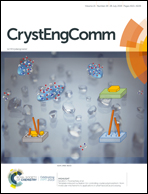Structural and spectroscopy characterization of coaxial GaAs/GaAsSb/GaAs single quantum well nanowires fabricated by molecular beam epitaxy†
Abstract
GaAsSb-Based QW structure nanowires play an important role in the field of nano-optoelectronics. In this manuscript, we report the epitaxial growth of GaAs/GaAs0.75Sb0.25/GaAs single quantum well (SQW) nanowires on a Si (111) substrate by solid source molecular beam epitaxy (SS-MBE) and study the morphology, structure and optical properties of the nanowires. Two morphologies of SQW nanowires are observed, essentially caused by Ga droplets at the top of a small number of nanowires which were not completely consumed. The structure of GaAs/GaAsSb/GaAs SQW nanowires was characterized by transmission electron microscopy (TEM) and energy dispersive X-ray spectroscopy (EDXS). The results show that the nanowires have a zinc blende crystal structure. The photoluminescence (PL) spectrum of GaAs/GaAs0.75Sb0.25/GaAs SQW nanowires shows a peak emission wavelength of ∼1.2 μm at room temperature. Finally, the controllable growth of nanowires was explored by changing the Ga interruption time. This work would have a positive influence on the development of optoelectronic devices based on GaAs/GaAsSb/GaAs quantum well nanowires.



 Please wait while we load your content...
Please wait while we load your content...